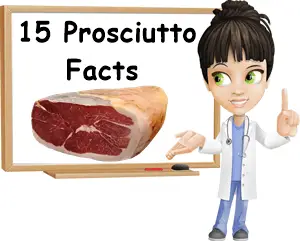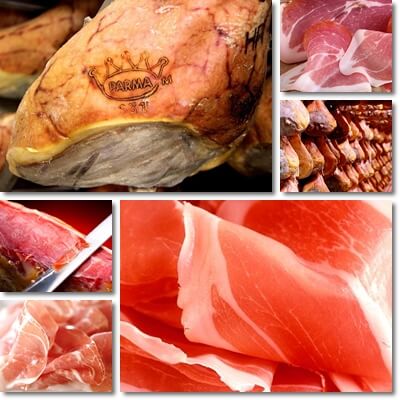1: What is prosciutto?
Prosciutto is a type of traditional Italian ham. There are two major types of prosciutto: crudo, as in raw or uncooked, and cotto, as in cooked.
Prosciutto crudo is an internationally certified PDO, Protected Designation of Origin agricultural food product (DOP in Italian). Original prosciutto crudo is made only in certain regions of Italy, according to traditional recipes, with high-quality ingredients, no preservatives and only from pig hind legs.
It can be recognized by its rind which is fire branded with the name of the ham and place of production (which often coincide), a logo and sometimes also a date, usually the year when the production of said specialty began or the start of the curing process.
2: What is prosciutto crudo?
Prosciutto crudo is a traditional, salt-cured Italian ham of international recognition. It is a PDO, meaning a Protected Designation of Origin agricultural food product (DOP in Italian), as recognized by European Union legislation.
Prosciutto crudo is a specialty Italian ham made made from pig’s back leg, either a whole leg with bone and foot or just the upper part of the leg (thigh). As its name says, prosciutto crudo is raw meat (crudo), but nonetheless cured.

3: What is prosciutto cotto?
Prosciutto cotto is a boneless, salt-cured and cooked Italian ham. It is a traditional Italian food product, a certified Prodotto agroalimentare tradizionale (PAT), meaning a traditional agricultural food product. While it’s officially recognized only regionally, in Italy, prosciutto cotto is known internationally. As its name says, it is cooked (cotto), but also cured. Similar to crudo, it is made from pig’s back leg, but only the top part and without the bone.
4: Is prosciutto pig meat or beef?
Original Italian prosciutto is made from pork meat. More exactly, from pig’s back legs. Prosciutto crudo is made from either a whole pig’s back leg, with bone and foot, or just the upper part of the pig’s leg (the thigh). By comparison, prosciutto cotto is made only from the top part of a pig’s back leg, without the bone (the pig back leg thigh is pressed to make the ham compact). See more differences between prosciutto crudo and cotto.
However, there can be and actually are specialty prosciuttos (or prosciutti) made from other types of meat. For example, there is lamb (prosciutto d’agnello), sheep (prosciutto di pecora), goose (prosciutto d’oca) and more. While you can make prosciutto from any type of meat, whether game, beef or poultry, it’s not original, traditional Italian prosciutto, PDO or DOP-certified.

5: Is prosciutto like ham?
Prosciutto is not like ham – it’s actually a type of ham. By definition, ham is a food product traditionally made from a specific cut of pork – pig hind leg – and preserved through salt-curing, either dry-curing or wet-curing, with or without smoking.
Prosciutto is made from pig hind leg and salt-cured, and thus a ham. Other specialty types of ham include: Prague ham, Bayonne ham or jambon de Bayonne (PGI, Protected Geographical Indication certification), Westphalian ham (PGI), Speck Alto Adige (PGI), Tyrolean speck (PGI), Jamon Iberico or Iberian ham, Jamon serrano (TSG, Traditional Specialties Guaranteed), Smithfield ham etc.
6: Is prosciutto like bacon?
Actually, no, prosciutto is not like bacon. For one, prosciutto is made only from pork hind legs, whereas bacon is made from different cuts of pork: pork belly, blade or blade shoulder, loin, head (such as jowl bacon made from pork cheeks) etc.
Another difference between prosciutto and bacon is that neither prosciutto crudo nor cotto need cooking and can be eaten as they are. Bacon on the other hand does need cooking (both fresh and dry bacon have to be cooked prior to consumption) and only cooked bacon doesn’t have to be cooked.
7: Does prosciutto go bad?
All foods spoil after some time or if they are not stored properly. Prosciutto crudo doesn’t go bad very soon because it’s salt-cured and aged (for at least 12-13 months and up to 2-3 years). So long as it’s kept relatively cool, it should last up to a year, the whole cured pig leg that is. Even if it’s already trimmed.
In worst case, the last slice may be removed if it’s exposed to air for 2 days or longer. The cured meat will oxidize and change color, turning darker as a result of exposure to air – at this point it’s best to just discard the slice. Sliced and packaged prosciutto crudo spoils faster (around 3-4 weeks) and usually needs to be refrigerated once the package is opened.
Versus crudo, prosciutto cotto needs to be refrigerated at all times and won’t go bad for as long as it says on the label.
8: Does prosciutto need cooking?
No, prosciutto doesn’t need any cooking. Both prosciutto crudo and cotto can be eaten as they are because one is cured and aged and the other is cured and cooked. But while prosciutto does not have to be cooked, it can be. For example, you can pan-fry prosciutto slices to make them crispy and brittle and get them to release their saltiness (no oil needed). Or bake it. Or roast it. You can do anything you like or think will taste good with your prosciutto.
9: Is prosciutto raw?
The name prosciutto crudo means ‘raw prosciutto’. However, the prosciutto is not entirely raw. To be more exact, it’s cured raw meat. The curing is what makes renders it safe to eat, event though it’s not cooked. Prosciutto cotto on the other hand isn’t raw; as its name says, it’s cooked (‘cotto’).
10: Is prosciutto aged?
Prosciutto crudo is aged whereas cotto isn’t. Original Italian prosciutto crudo is salt-cured and aged for at least 12-13 months or up to 2-3 years. Prosciutto cotto on the other hand isn’t, at least not for that long. It’s salted and left to sit for a little while which helps remove the moisture and blood from the meat before being cooked, which somewhat counts as aging.
11: Is prosciutto dry-cured?
Prosciutto crudo is dry-cured. That is, the whole pig back leg is salted, sometimes several times, and hung to air dry and age for 12-13 months and up to 2-3 years. As for prosciutto cotto, there are two recipes. Either the meat is salted and left to sit to reduce its moisture content, after which it’s cooked or, in home recipes especially, immersed in a salt-water solution to brine and then cooked.
12: Is prosciutto vegetarian?
Original Italian prosciutto with PDO (DOP) certification is not a vegetarian food product. It is made exclusively from pork, more exactly pig back legs. At most, the part opposite to the pig’s foot where the meat is exposed is covered with a mixture of grease, usually pork lard, and cereal flour or rice flour and various spices and herbs. This is to protect the meat during the lengthy curing process.
13: Does prosciutto have preservatives?
Original Italian prosciutto crudo with PDO, Protected Designation of Origin certification (DOP in Italian) has no preservatives. In order to qualify for the European Union certification, only sea salt can be used for curing, as per the traditional recipes after which the prosciutto is made. As a result, the pig hind leg is exclusively salt-cured, a natural process that helps preserve the meat for years as well as helps it develop particular flavors. Original Italian prosciutto cotto is also commonly preservative-free. However, all prosciutto that is not PDO or DOP-certified likely contains preservatives.
14: Does prosciutto have nitrites and nitrates?
PDO or DOP-certified prosciutto crudo does not have any added nitrites or nitrates as its certification requires no preservatives be used in the production process. However, prosciutto with this certification is likely to have added nitrites or nitrates.
15: Does prosciutto have sugar or gluten?
The edible part of PDO or DOP prosciutto does not have any added sugar or gluten. However, the part opposite to the pig’s foot where the meat is exposed is covered with a mixture of grease, usually pork lard, and cereal flour or rice flour and various spices and herbs, so the meat won’t spoil during the lengthy curing process. So there may be some gluten there, from the cereal grains. However, that part is not eaten.
